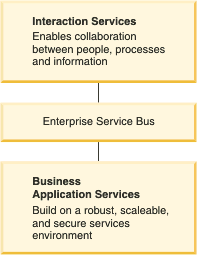WebSphere Commerce integration with WebSphere Portal
You can integrate WebSphere Commerce, a Business Application Service with WebSphere Portal, an Interaction Service. The Interaction Service provides core portal services (WebSphere Portal) that aggregate applications and content and deliver them as role-based applications. The Enterprise Service Bus (ESB) pattern is used for communication, mediation, transformation and integration with external systems. Using an ESB to integrate the Web services exposed from WebSphere Commerce to the WebSphere Portal promotes a loosely coupled design where the ESB manages the interactions styles between the WebSphere Commerce services and the presentation layer. You do not need to alter your presentation layer to support the protocol and format used by the WebSphere Commerce services. Instead, you rely on the ESB to perform tasks such as message transformation and protocol mediation. Neither WebSphere Commerce nor WebSphere Portal needs to change in order to communicate with one another. The ESB is used to act as an interpreter between the two systems and will translate the messages into a format the receiving system understands.

This architecture is described in detail in the Logical Architecture Model section of IBM's SOA Foundation - An Architectural Introduction and Overview.
WebSphere Commerce and WebSphere Portal integration
The WebSphere Commerce and WebSphere Portal service-oriented integration support enable you to have an aggregated presentation of WebSphere Commerce Services and non-WebSphere Commerce services. The benefits are:
- WebSphere Portal provides the ability to aggregate and to present contents delivered from services, whether they are provided by WebSphere Commerce or a 3rd party application.
- Single sign on from WebSphere Portal provides a secure method of authenticating a user one time within an environment and using that single authentication (for the duration of the session) as a basis for access to WebSphere Commerce Services.
- Portlets that render WebSphere Commerce content are JSR-168 compliant, enabling them to work with other vendors' portlets in a single portlet container. JSR-168 compliance also allows you to leverage tools that are designed for JSR-168.
- Have your WebSphere Commerce portlets communicate with your other portlets to deliver a rich user experience.
- Leverage the portlet tag library from WebSphere Portal.